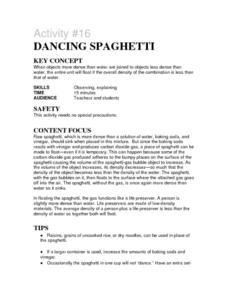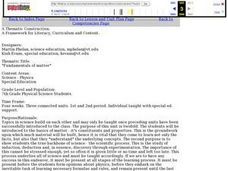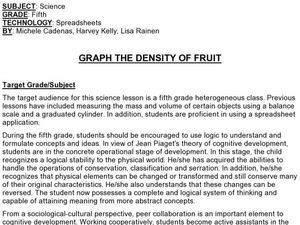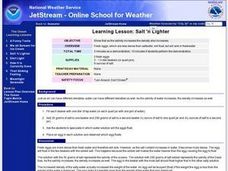Curated OER
Activity #19 The Density of Alka Seltzer Gas
Learners (teachers) complete the activity, they should not come in contact with Alka-Seltzer. They comprehend that the density of a gas can be calculated from its mass and volume. Pupils calculate the volume of gas generated by...
Curated OER
Activity #6 'Nothing' Matters: A Demonstration
Students observe the 'pouring' of a gas. They compare the masses (weights) and densities of two gases. Pupils define the following terms: matter, mass, and density. Students answer questions after watching the demonstration.
Curated OER
DENSITIES OF REGULARLY SHAPED SOLIDS
Students calculate the volumes of regularly shaped objects from measurements of their dimensions. They use several formulas and measure different objects to calculate the density, volume, and mass of the objects selected or assigned.
Curated OER
Activity # 13 Float or Sink?
Students have seen that solids, which are more dense than a liquid, that sinks in that liquid and solids, which are less dense than a liquid, that floats on that liquid. They use a metal boat to float in water. Pupils comprehend that...
Curated OER
Activity #15 The Cartesian diver
Students comprehend that the Cartesian diver is a dropper and the water and air inside it. They vary the volume of the air and the amount of water, the diver can be made to be either more or less dense than water. Pupils squeeze the...
Curated OER
Activity #16 Dancing Spagehetti
Learners experiment with floating the spaghetti, the gas functions like a life preserver. Pupils comprehend that a person is slightly more dense than water. They comprehend that a life preservers are made of low-density materials. The...
Curated OER
Activity #17 Liquid Density and Temperature
Learners comprehend that hot water rises up through cold water but cold water does not rixe in hot water. They comprehend that water at temperatures above 4oC decreases in density with increases in temperature. Students answer lab...
Curated OER
Determining Liquid Densities
Middle schoolers practice determining liquid densities in a short, hands-on lab activity. Students use a graduated cylinder to measure out 100 milliliters of a liquid, find its mass using a balance, and record measurements in a data...
Curated OER
Graphical Determination of Density
Young scholars determine the density of metal shot by a graphical method using significant digits in making measurements and calculations. Students graph a seris of laboratory measurements and determine density from a mass verses volume...
Curated OER
Buoyancy
Students look at clippings of boats. They are able to define the following terms displacement, and density. Students construct a clay boat. After they complete their clay boat students answer questions about their clay boats.
Curated OER
Fundamentals of Matter
Seventh graders explore the the constituents and properties of matter. They use the scientific process while exploring solids, liquids, gases, the mass, volume and density of matter. Students plan and conduct an investigation to measure...
Curated OER
Math Lesson: How Many People Live There?
Students are able to calculate the population density of a country, and calculate the population density of large cities in that country. They are able to create an appropriate graph to represent their data for that country.
Curated OER
The Causes of Differences in Density
Students discuss the each of the following objects/substances in terms of what contributes to their density: 1) a piece of copper; 2) a piece of bread; 3) steam in the air. They evaluate the causes in the various densities of substances.
Curated OER
The Buoyancy Factor
Students examine why some objects float in water while others sink and the ability of something to float does not depend entirely on its weight. Archimedes' principle is introduced and buoyant force is discussed. Practice calculations...
Curated OER
Estimating the Live Mass of Dinosaurs
Students calculate the volume of scale model dinosaurs using a water displacement method. They use formulas to calculate the live mass each of the species of dinosaur. Then they complete and discuss a series of questions.
Curated OER
Graph the Density of Fruit
Fifth graders review the definition of mass and volume. They calculate and graph the density of various types of fruit while working in groups on a spreadsheet program. They look at how size of the fruit can be similar but the weight is...
Curated OER
Causal Patterns in Density Phenomena
Students consider the causes of density at a microscopic level. They then discover that one cause of density has to do with how many protons and neutrons the material contains.
Curated OER
Observing and Classifying Rocks
Fourth graders examine various types of rocks and record their properties. They collect rocks at home and bring them to school where they are mixed and distributed to groups of students. After writing their observations on...
Curated OER
Egg Measurement
Students explore measurement and units. They measure eggs to determine their density, mass and percent composition. An inquiry approach is used for students to ascertain the mass.
Curated OER
Marine Debris on the Chesapeake Bay
Students use website to study estuarine debris data. They study the density of marine debris.
Curated OER
Density Stratification and Ocean Circulation
Students examine how circulation currents of the ocean. They use a tub of hot and cold water to demonstrate the currents. They discover how salinity and temperature of water affect its movement.
Curated OER
New Jersey Estuaries
Students experiment to discover that salt water is denser than fresh water by creating color coded solutions. They examine how heavy rainstorms and high tides develop layers of different degrees of density.
Curated OER
Learning Lesson: Salt 'n Lighter
Pupils participate in a demonstration showing that as salinity increases density increases as well. They also examine the different densities of air. They discuss the amount of water displaced by large ships.
Curated OER
Mission Planning: Earth/Mars Comparisons
Students compare and contrast conditions on Mars to those on our own planet, specifically, their local or regional environments. The physical characteristics, the atmosphere, and other astronomical data is considered.

























